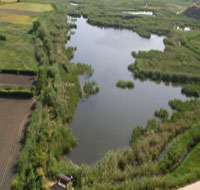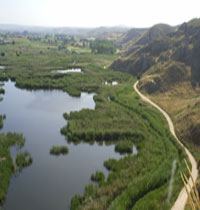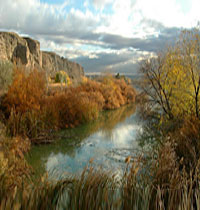Tourism web of Chinchón (Spain)
Environment
Protected areas
Laguna de San Juan
Is the most important wetland area and characteristic of the Chinchón area and one of the largest bird reserves in the whole of the Community of Madrid.
The Fauna Refuge of San Juan Lagoon was converted into a protected area by order of Decree 5/1991 of the Community of Madrid, and it is devoted to preserving, restoring and improving the fauna and flora for biological, scientific and educational reasons due to the unique character of its relief and landscape value. This protection must remain compatible with the local traditions and an orderly use of its natural resources.
It has a Management Plan approved by Order of December 14/1992 and it is administered and managed by a Council for the Environment of the Community of Madrid.
It covers an area of 40 hectares and is found along the lower course of the River Tajuña and it is the largest area of the three wetlands associated with this stretch of the river.


It has a triangular shape surrounded by reeds, rushes and cane as well as other species with a marked hydrological system depending on the seasons and consisting of two spreads of water separated by an artificial dike, surrounded by a series of hillocks and cliffs of great height with very interesting vegetation and fauna.
It is perhaps the best example of the marshy ecosystem and an ideal habitat for water fowl. Over 43 species of vertebrates have been catalogued, of which half are birds. Some make their nests here all through the year and others hibernate or make sporadic visits. There are also reptiles, amphibians and small mammals.
The lagoon is afforded protection by a blanket ban on hunting, fishing and the capture of animals or eggs, dumping and extraction, the introduction of non-native species, camping, lighting fires as well as off-road traffic and the placing of publicity hoardings. In any event, its state of conservation is fairly good and it is not under threat due to its distance from highways and built-up areas.
Parque del Sureste
It is officially called the "Regional Park around the hubs of the lower courses of the Rivers Manzanares and Jarama" and was created by Law 6/1994 of June 28. Protected by Law 4/1989 and Law 2/1991(of the Community of Madrid) it was declared as such without the need for any Zoning Plan for Natural Resources so as to stop the degree of deterioration it had been subject to. The Plan was passed by decree 27/1999 of February 11.
It has an approximate surface area of 31,550 hectares. Including the protected area, it covers 16 municipalities from Pinto and Getafe as far as Aranjuez.
Chinchón is affected inside the park in an area called El Pingarrón, and also as a protected area because the boundaries of its municipality along the west are the same ones as the Regional Park.

In this territory there is a mixture of agriculture, forestry, residential housing, mines, industries, ecological reserves and leisure areas. The biggest threat to them are open pit mining, uncontrolled dumping from the populated areas and industries, the channeling of the River Jarama, the High Speed Train and any new infrastructure.
It is therefore a very threatened area and difficult to manage but one which has very beautiful landscapes well conserved and with a high ecological and archeological value. It has a conservation service that has undertaken jobs related to recovery, restoring, cleaning and which has established itineraries and leisure areas.
It is very important because of its flora and fauna and many of its species found there are confined also to the Regional Catalogue of Endangered Species of the Community of Madrid.
This park is included within the LIC "Vegas, Southeast Slopes and Moors" that will become part of the Natura 2000 network.





